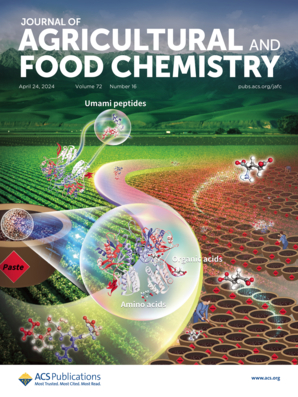3d - qsar引导的琥珀酸脱氢酶抑制剂的分子设计和蛋白质-配体相互作用研究。
IF 5.7
1区 农林科学
Q1 AGRICULTURE, MULTIDISCIPLINARY
引用次数: 0
摘要
琥珀酸脱氢酶(SDH)是一种理想的杀菌剂。本文利用74个具有抗枯丝核菌活性的化合物的数据,建立了三维定量构效关系(3D-QSAR)。通过将我们之前报道的3D-QSAR发现与当前模型相结合,合理设计和合成了一系列含吡唑的化合物。生物测定结果表明,B5对茄病螨的EC50值为0.002 μg/mL,优于氟沙吡沙(0.01 μg/mL)。酶活性测定结果显示,B5的IC50为0.12 μM,显著优于氟沙吡虫胺(0.35 μM)。在200 μg/mL浓度下,B5的体内杀真菌活性为94.44%,与氟沙吡虫沙的88.89%相当。转录组学分析表明B5影响三羧酸循环,与传统的琥珀酸脱氢酶抑制剂具有相同的作用模式。分子对接和分子动力学模拟表明,B5的结合模式与其抗真菌活性密切相关。值得注意的是,B5是一个没有噻唑亚结构的先导化合物,值得进一步研究。本文章由计算机程序翻译,如有差异,请以英文原文为准。
3D-QSAR-Guided Molecule Design and Protein-Ligand Interaction Studies for Discovery of Succinate Dehydrogenase Inhibitors.
Succinate dehydrogenase (SDH) is an ideal fungicidal target. Here, a three-dimensional quantitative structure-activity relationship (3D-QSAR) was established based on the data of 74 compounds with activity against Rhizoctonia solani. By integrating our previously reported 3D-QSAR findings with the current model, a series of pyrazole-containing compounds were rationally designed and synthesized. Bioassay results demonstrated that B5, with an EC50 of 0.002 μg/mL against R. solani, outperformed fluxapyroxad (0.01 μg/mL). Enzyme activity assays revealed that the IC50 of B5 was 0.12 μM, significantly better than that of fluxapyroxad (0.35 μM). The in vivo fungicidal activity of B5 was 94.44% at 200 μg/mL, which was comparable to that of fluxapyroxad (88.89%). Transcriptomic analysis indicated that B5 affects the tricarboxylic acid cycle, sharing the same mode of action as the traditional succinate dehydrogenase inhibitors. Molecular docking and molecular dynamics simulations revealed that the binding modes of B5 were strongly correlated to its potent antifungal activity. Notably, B5, a lead compound without a thiazole substructure, is worthy of further investigation.
求助全文
通过发布文献求助,成功后即可免费获取论文全文。
去求助
来源期刊
CiteScore
9.90
自引率
8.20%
发文量
1375
审稿时长
2.3 months
期刊介绍:
The Journal of Agricultural and Food Chemistry publishes high-quality, cutting edge original research representing complete studies and research advances dealing with the chemistry and biochemistry of agriculture and food. The Journal also encourages papers with chemistry and/or biochemistry as a major component combined with biological/sensory/nutritional/toxicological evaluation related to agriculture and/or food.

 求助内容:
求助内容: 应助结果提醒方式:
应助结果提醒方式:


